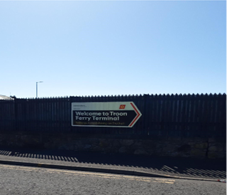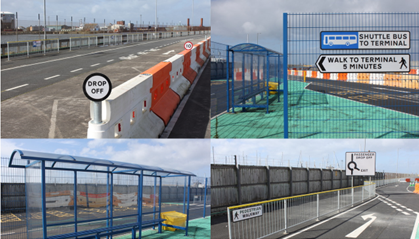Q&A - Troon Harbour Project
Project Update
In January 2024 CalMac commenced freight services from Troon port to Brodick, utilising the MV Alfred. A full service including cars and passengers was then later implemented following the closure of the Irish Berth at Ardrossan with the service being supported by a shuttle bus which operates between the ferry port and Troon railway station.
The port facility is being updated to include additional signage following feedback from island communities and users. We continue to engage with the Isle of Arran Ferry Committee and look to address any operational issues timeously.
The temporary terminal building is in use with the permanent drainage works being progressed by CMAL on behalf of Transport Scotland.
Car Parking Charging Metres are expected to installed at Troon by end July 2024 . The cost to park at the ferry port will be charged in line with that imposed at Ardrossan Harbour. Any queries arising regarding payment should be directed to Associated British Ports as the owners and as statutory harbour authority.
The project working group exists to support ferry services from the port and includes representatives from Associated British Ports, Transport Scotland, CalMac and CMAL. The project partners regularly engage with key stakeholders including the Isle of Arran Ferry Committee and Troon Community Council.
When will services move to Troon?
The move to Troon will be triggered by the introduction of the MV Glen Sannox when deployed to the route.
The service continuity plans for when services temporarily relocate to Troon have been progressed with input from community representatives and are being considered by Transport Scotland for a decision and funding approval subject to affordability.
Troon is being used to support Arran services with the MV Alfred. It will be utilised as an alternative mainland port, therefore, services may operate to Troon on a temporary basis if this is deemed appropriate in order to maintain services across the wider ferry network.
What will the level of ferry services be at Troon?
Our aim is to provide as close to the current Ardrossan-Brodick timetable where possible when operating out of Troon. However users should be aware that passage and turnaround times are expected to be longer during operation, up to 20 (passage time) and 55 minutes(turnaround time).
No final decision has been undertaken regarding service levels; the timetables will recognise the demand on the service.
What about passengers facilities at Troon?
- The landside infrastructure required to operate services include facilities, such as a temporary terminal building, shuttle bus service, car parking, marshalling area and public toilets.
- Connectivity for onward travel is a key component including integration with other modes which is being developed as part of the service continuity plans.
- CMAL on behalf of Transport Scotland completed the delivery of the terminal building and continue to engage with CalMac as operator should any issues arise.
How long is the walk from the terminal building to the bus stop and car park?
- From the bottom of the vessel gangway at Troon to the first bus pick up point (no stairs) is about 145metres and just 110metres if you are walking up the linkspan
- From the passenger terminal to the car park this is about a five minute walk or 700 metres
- Bus stop pick up points at the main car park take you directly to the terminal building.
- The width of the passenger walkways are 1.5m thus allowing adequate space for users with luggage/prams etc
What consideration has been given to notifying travellers of the ferry service when it operates out of Troon?
- As part of service continuity planning this will be done in advance of the service moving to Troon to ensure that it is communicated as widely as possible.
- In addition to support the service, shuttle-bus services will also be available from Ardrossan to Troon and between Troon railway station and port.
- The tender bids for the shuttle bus provision have been reviewed and will be submitted to Transport Scotland for a decision.
- The working group is also engaging with Ayrshire Road Alliance and ScotRail regarding traveller information.
How will the MV Glen Sannox be fuelled at Troon and how long with this take?
- There are no plans for a permanent LNG facility at Troon therefore re-fuelling will be done directly from HGV tanker to vessel. CalMac, as operator will lead this operation and will ensure it is conducted as per safety and Health and Safety Executive (HSE) protocols.
- This operation is being accounted for within the timetable development whereby minimising any disruption to services where practicable.
Is there an update on the works at Troon railway station?
- Works are expected to be completed by Summer 2024.
- CalMac have been, and will continue to engage with Network Rail and ScotRail regarding the station works including station access as part of the service continuity planning for onward travel connections.
- Network Rail link to project updates: Troon Station redevelopment plans revealed at community event (networkrailmediacentre.co.uk)
More information/webpage links:
Site visuals



Walking distances on site


